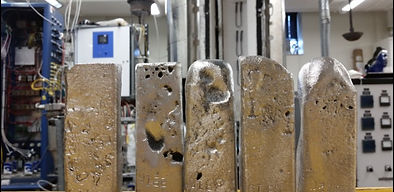RESEARCH & DEVELOPMENT
In addition to our established markets, Garrison Minerals is continually exploring new opportunities for magnesium compounds, specifically magnesium hydroxide. Through collaboration with our partners, academic institutions, and government agencies, we are actively investigating the following applications:
Battery Metal Recovery
The worldwide volume of spent lithium-ion batteries is expected to increase from 0.2 to 1.2 million tons between 2020 and 2030. Today, there is no technology or domestic infrastructure to recover and recycle the critical materials found in end-of-life batteries. Additionally, the U.S. no longer produces appreciable quantities of cobalt, manganese, or graphite, and has only one major producer of lithium.
There is a profound need to retain critical materials from these batteries and reinsert them into manufacturing processes in an economical way. Using a novel leaching and recovery technique, a U.S.-based supply chain can be integrated with existing battery manufacturers to provide a stable, anchoring source of critical raw materials.

Acid Mine Drainage
The history of hard rock mining in the US (and throughout the world) has left us with many sites (often abandoned) that discharge highly acidic wastewater that may contain dangerous levels of dissolved metals.
Various active and passive treatment systems have been proposed and tested which raise pH and encourage precipitation of the metals in solution.

While lime (calcium hydroxide) is traditionally utilized as a neutralizer, there is an interesting case for the use of magnesium hydroxide due to the potential for much lower sludge volume.
Magnesium Metal
Magnesium is the lightest structural metal which is why it's the material of choice for many applications where ultra-portability and reduced weight are desired. Automotive light-weighting represents one of the largest demand segments, contributing to increased fuel economy and EV range. However, the production of this metal requires enormous amounts of energy and can sometimes lead to severe environmental impacts.

A new process methodology is currently under development to halve the energy intensity, reduce processing complexity, and eliminate the release of toxic compounds into the local environment. This novel smelting technique exploits carbothermic chemistry for the economical and clean production of magnesium metal from oxide-based ores.
Nuclear Waste Disposal
Currently, the best system we have for safely isolating nuclear waste is to bury it in deep underground salt formations and allow the natural settling of the surrounding geology to seal off the waste compartments. There exists, however, the possibility that highly acidic brine water could make its way into contact with the waste. If unmitigated, this scenario could result in radioactive material being dissolved and mobilized into the surrounding water table.

To defend against the possibility of acid intrusion, magnesium hydroxide (or magnesium oxide) is placed around the waste material, forming an ‘engineered barrier’.
